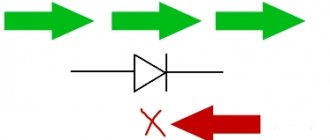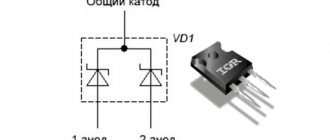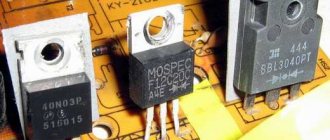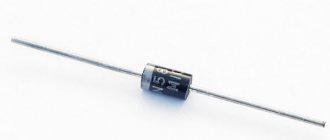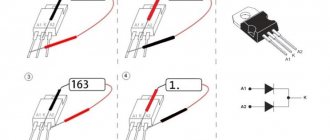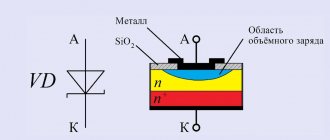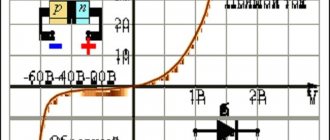The 1N5822 semiconductor device is an ordinary Schottky diode; its main characteristics (in Russian) will be discussed in this article. It is designed for use in high-frequency pulse circuits and is designed to work with small power supplies (up to 40 V) with an average rectified current of up to 3 A. Quite often found in older UPSs in the rectifier or voltage stabilizer circuit, as well as as open-circuit protection components and polarity changes.
Many people, especially beginner radio amateurs, incorrectly refer to the 1N5822 diode, calling it “in5822”. This error is most likely related to the device’s markings, at the very beginning of which the “IN” symbols are clearly visible on the black background of the plastic case.
Part Description
Externally, the electronic component is no different from an ordinary diode. Its miniature DO-201AD body is cylindrical in shape. It is made of heat-resistant black plastic. On the sides are two copper terminals called the anode and cathode. They are necessary to fix the 1N5822 on the printed circuit board and connect the part with other elements of the circuit. The terminals are covered with a thin layer of solder. If the part is new, then they have a characteristic silvery shine. After installing the diode in the desired location, the legs are shortened to the minimum size.
The part in question belongs to the category of so-called Schottky barrier diodes. Their main difference from conventional semiconductor rectifiers, like the 1N4007, is the low voltage drop when turned on in the forward direction. It is 0.2-0.4 V versus the typical 0.6-0.7 V for conventional silicon diodes.
This feature allows the 1N5822 Schottky diode to be used in circuits with higher currents. After all, the lower the voltage drop across the diode, the less power dissipated on it. This implies another advantage of this category of rectifiers. Their chip generates a small amount of heat, so the part body has smaller dimensions, and in some cases the use of radiators or forced cooling can be avoided.
Additional Information. By connecting two diodes in parallel, you can achieve an even smaller voltage drop. This in turn will double the maximum current allowed through such an assembly. This solution is often used by electronics manufacturers. Parts are also produced that already contain two diodes connected in parallel in one housing.
Another feature of Schottky diodes, incl. and 1N5822, follows from its structure. In this part, the usual electron-hole pn junction is replaced by a metal-semiconductor structure. This structure made it possible to significantly reduce the input parasitic capacitance of the element and, as a result, to use it in higher-frequency circuits.
Structure of a Schottky diode
Tsokolevka
The 1N5822 is manufactured by most manufacturers in a molded plastic DO-27 housing (modern equivalent to DO-201AD), which meets the UL 94V-0 fire rating. It has two flexible axial leads prepared for soldering according to the American MIL-STD standard (usually not lower than MIL-STD-202). The cathode side is marked with a special gray mark. The weight of the device does not exceed 1.1-1.2 g. The appearance and dimensions are shown in the figure.
Almost all manufacturing companies are trying to adapt the latest versions of the device in question to the requirements of environmental standards of the European RoHS directive and Pb-Free lead-free technology standards. More detailed information about this can be found in the technical description for the selected product from the manufacturer (datasheet).
Specifications 1N5822
Schottky diode
Due to the metal-semiconductor structure, the IN5822 has very ambiguous characteristics. The diode is distinguished by its ability to pass large currents. At the same time, it is unsuitable for working with high voltages. This applies not only to the element in question, but also to all Schottky barriers.
The maximum peak voltage that can be applied to the pins of the 1N5822 is 40 V. With effective (RMS) voltage it is still more modest - no more than 28 V. Things are a little better with a single peak surge of reverse voltage. In such a situation, the 1N5822 is able to withstand a potential difference between the terminals of up to 48 volts.
If we are talking about continuous operation, then in the forward direction the maximum current value should not exceed 3 A. The pulse value can reach up to 80 amperes (single burst). This value was obtained during testing of the component. The pulse had the shape of a half-sine wave and lasted 8.3 ms. The temperature of 1N5822 at the time of the test was 25 C.
It is equally important for the normal functioning of the diode to comply with environmental conditions. The permissible operating temperature range for the 1N5822 is -65 to +125 C. This parameter is extremely important when reverse voltage is applied to the diode. It certainly leads to leakage current. At the same time, at 20 C it will be 2 mA, and at 100 C it will sharply increase to 20 mA. This avalanche-like dependence of leakage current on temperature requires special control over overheating of the 1N5822.
Diode Characteristics
Less significant technical properties:
- Maximum soldering temperature – 275 C (heating for 10 seconds);
- Thermal resistance – 10-40 C/W (depending on the length of the leads and the heat sink area);
- Weight – approximately 1.1 g.
The closest Soviet analogues of 1 N 5822 include the following Russian diodes:
- KD238VS – 45V, 7.5A;
- KD269B – 50V, 5A;
You can purchase them in the popular Russian online store “CHIP and DIP”. As of November 3, 2022, the most expensive of these two diodes turned out to be KD269B - 54 rubles/piece. You can also buy 1N5822 there - 6 rubles / piece.
Important! Overvoltages are possible in any electronic devices. Taking into account the fact that the 5822 cannot withstand even minimal voltage surges for a long time, this diode should be installed with a reserve. That is, if the Schottky barrier is designed for 40 V, then it is better not to take risks and not place it in circuits with voltages higher than 20-30 volts.
Advantages and disadvantages
Despite its good parameters, 1n5819 is not capable of becoming a full-fledged replacement for conventional pn junction rectifier diodes. This is due to its design features and properties. It works well in high-frequency circuits and heats up less due to its low forward voltage drop. But there are also disadvantages that outweigh all these advantages.
Compared to conventional diodes, which are unable to operate in high-frequency modes, Schottky diodes have a much lower maximum permissible reverse voltage. They have much higher leakage current, which increases disproportionately quickly with increasing chip temperature. This can be clearly seen if you compare the parameters from the datasheets of these devices with each other.
Dimensions and pinout of the 1N5822 diode
Diode color coding
Each type of radio component housing has its own specific dimensions. The number of pins and their purpose also differ. These things are taken into account at the design stage of a printed circuit board, when it represents only a computer model. Therefore, without knowing the dimensions and purpose of the pins of an electronic component, it cannot be used to create a new device.
The anode and cathode of the 1N5822 diode are located on the sides of the part. To determine which pin is which, there is a special marking on the case in the form of a strip. It is applied from the cathode side. The leads are made of copper wire with a diameter of 1.22 to 1.32 mm. For programs that do not favor the metric measurement system, you will have to take into account dimensions in inches. In this case, the thickness of the leads is from 0.048 to 0.052 inch. Such dimensions were not taken out of thin air, because the terminals of the part must confidently and without heating withstand the currents passing through them.
Strip on 1N5822
Note! Most imported and domestic diodes have a strip on the cathode side. Some Soviet parts are marked the other way around, i.e. strip on the anode side. Incorrect activation can lead to failure of both the diode itself and some (sometimes very rare and expensive!) parts on the board in which it is installed.
The length of the legs of the radio component is also standardized. For 1N5822 it is exactly 25.4 mm or 1 inch. Manufacturers do not skimp on copper for making leads, so their length is always made with a margin. After installing the part on the printed circuit board, excess fragments of the legs are bitten off using wire cutters. In some cases, the diode leads are not shortened and are left for additional cooling. Manufacturers of high-quality electronics do not accept such methods, because a heavy part mounted on long legs will break them off over time.
The dimensions of the case are no less important. The 1N5822 diode in the DO-201AD package has a length from 7.2 to 9.5 mm. Accordingly, 0.285 – 0.375 inch. In this case, the diameter ranges from 4.8 to 5.3 mm (0.19 – 0.21 inch). Compared to other diodes, the sizes are quite large. They are directly related to the current passing through the part and the thermal power that the housing must dissipate. The more massive it is, and the larger the area of its contact with air, the more successfully the part gets rid of excess heat.
Dimensions 1N5822
Manufacturers and DataSheet
Let's list the major manufacturers and their datasheets that produce the 1N5822 diode:
- Motorola;
- Diodes Incorporated;
- Micro Commercial Components;
- Won-Top Electronics;
- Pan Jit International;
- Nanjing International Group;
- EIC discrete Semiconductors;
- Microsemi Corporation;
- Diotec Semiconductor;
- HY ELECTRONIC.
The products of these companies can be found in domestic stores:
- STMicroelectronics;
- ON Semiconductor;
- Kingtronics International Company;
- Taiwan Semiconductor Company;
- Vishay Siliconix;
- DC Components;
- Rectron Semiconductor.
Flaws
1n5819 diode: characteristics
The main disadvantage of the 1N5822 diode is its low reverse voltage of 40 volts. This problem is common to all Schottky barriers and is explained by the peculiarity of their structure. A conventional diode, after breakdown by increased reverse voltage, in some cases is able to return to normal operation. With Schottky diodes, such as 1N5822, such a miracle will no longer happen, and the part will completely fail. This reverse voltage characteristic condemns these electronic components to operate only in low-voltage circuits. This means that their versatility and the number of devices in which they can be found are significantly reduced.
The second disadvantage of the 1N5822 is its high reverse leakage current. We are talking about connecting a part in which a greater potential is applied to the cathode than to the anode. Ideally, a pn junction should not conduct current in this direction. In fact, some of the charges still flow in the opposite direction. Therefore, this current is called leakage, i.e. something unwanted and wrong.
This problem is again characteristic of all Schottky barriers, and not just 1N5822. For this particular diode, the leakage current strongly depends on temperature and can reach 0.2 amperes. In this case, the problem has an avalanche-like character, i.e., if reverse current begins to flow through the diode, it heats up. An increase in temperature, in turn, leads to an increase in leakage. This increases the heating even more. So in a vicious circle until the part finally overheats and its thermal breakdown occurs, which is irreversible. Therefore, if the 1N5822 will be used in conditions close to overload, care should be taken to remove excess heat.
1N5822 is a diode whose characteristics allow it to be used in the output circuits of modern power supplies. It is becoming more and more in demand every day. This is explained by the ability to operate at high currents for such a housing, up to 3 amperes, and at fairly high frequencies.
Manufacturers
You can download datasheet 1N5822 (in Russian in pdf format) here. Currently, the considered diode is produced by almost all well-known foreign companies involved in microelectronics. It is also possible to view technical documentation using links with the manufacturer's name: ON Semiconductor, ST Microelectronics, DC Components, Vishay, Diodes Incorporated; Micro Commercial Components; Won-Top Electronics.
